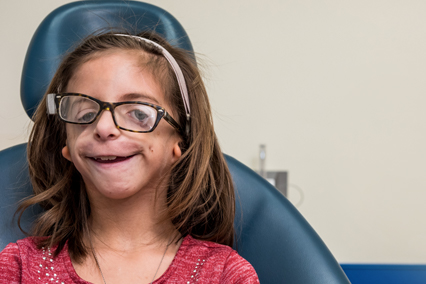JAWS Clinic
Jaw, airway and sleep clinic
The Children’s Mercy JAWS (jaw, airway and sleep) Clinic provides a single point of contact for children with jaw deformities that often require the expertise of specialists from several fields. The clinic is staffed by team members from plastic surgery, pulmonology and sleep, orthodontics and otolaryngology (ENT).
Conditions
The JAWS Clinic sees children from birth through young adulthood with a variety of jaw-related conditions. The most common condition we treat is Pierre Robin Sequence, where the lower jaw is smaller than expected and the tongue is pushed farther back. This creates an airway obstruction and often, a cleft palate.
Additional conditions we often see include:
-
Pierre Robin Sequence. A condition in which infants are born with a small lower jaw.
-
Stickler Syndrome. A genetic disorder in which a child exhibits prominent eyes, a small nose, and a receding chin. Often, children with Stickler also have a cleft palate.
-
Micrognathia. A condition characterized by an undersized (small) jaw.
-
Treacher Collins. A condition that affects the development of bones and tissue in the face, characterized by deformities of the ears, eyes, cheekbones, and chin.
-
Hemifacial Microsomia. A congenital disorder that affects the development of the lower half of the face, most commonly the ears, the mouth, and the mandible. It can involve one or both sides of the face.
-
Achondroplasia. A genetic disorder that results in dwarfism.
-
Obstructive Sleep Apnea. A condition in which breathing stops involuntarily for brief periods of time during sleep.
-
Crouzon Syndrome. A genetic disorder characterized by the premature fusion of certain skull bones. The early fusion prevents the skull from growing normally.
-
Pfeiffer Syndrome. A rare genetic disorder causing premature fusion of certain skull bones as well as bones in the hands and feet.
-
General jaw concerns. This may include overbite and underbite. Overbite is the overlapping of the lower teeth by the upper teeth, underbite occurs when the lower teeth overlap the upper teeth.
-
Maxillary or Mandibular Dysplasia. Underdevelopment of the maxillary or mandibular bones in the face.
One-stop consult
We want to help you feel more comfortable by sharing what to expect from your appointment at Children's Mercy.
At your first visit, you will meet with each of the JAWS Clinic professionals to evaluate your child's needs and create a treatment plan all together. This “one-stop” consult allows you to see all the specialists your child might need in one visit, including ear, nose and throat (ENT), pulmonary and sleep medicine, orthodontics and plastic/oral surgery.
Our goal is make the process as convenient as possible for your family, while ensuring all the specialists can provide valuable input on your child’s treatment plan.
Evaluations and testing
For most children, identifying the best treatment plan begins with a thorough physical and craniofacial exam, airway evaluation, imaging of the facial bones, 3D photos of the face, dental impressions, and a sleep evaluation. If your care team needs any further evaluations or follow-up testing, we’ll help you get those scheduled.
Airway evaluation
The ENT surgeon evaluates your child’s airway for potential sources of obstruction. This evaluation involves a clinical exam and, in some cases, endoscopic examination in the operating room.
If your child has obstruction (blockage) anywhere in their airway, sometimes surgery can help remove blockages and improve their ability to breathe. Surgical procedures may include procedures such as tonsillectomy, tongue base reduction, contouring of the upper part of the voice box (called supraglottoplasty), among others. In other cases, jaw surgery may be a consideration to enlarge the airway.
Sleep evaluation
Children with craniofacial problems are more likely to have sleep apnea. A sleep study can help the JAWS Clinic team determine if there is any obstructive apnea or other sleep-related disorder, and how severe it is. From there, the team can help you find the best course of treatment, which can include medications, CPAP therapy, surgery, and/or orthodontic care.
3D modeling
The JAWS Clinic team can make a model of your child’s facial bones using a 3D printer. This allows us to determine which strategies are the best approach to help relieve problems with breathing, chewing, and sleeping.
We will also work with your family to create a facial appearance and aesthetic that feels best to you and your child.
Treatment options
CPAP therapy
If your child has sleep apnea or other breathing problems, your team may recommend Continuous Positive Airway Pressure (CPAP) therapy, either while you’re waiting for surgery or if your child does not need surgery.
CPAP involves wearing a mask at night, which is attached to a machine that uses mild air pressure to keep airways open. In addition to CPAP, your team may recommend other therapies, such as medications or oxygen.
Surgery
When your child needs jaw surgery, the surgeon makes cuts in the upper and/or lower jaws, moves the bones into position and installs hardware (plates and screws) to fix the jaws in place.
In some cases, especially in a newborn baby or growing child, the surgeon will use a technique known as “distraction.” For several weeks after surgery, the doctor gradually turns screws to separate and lengthen the bone. The technique, originally used in limb-lengthening surgeries, extends the bone as part of the healing process.
Orthodontics
Depending on your child’s needs, our orthodontist collaborates with the team to determine the ideal timing and approach for their early intervention, or interceptive, orthodontics. This may include treatment at a younger age to aid in the improvement of their sleep disturbances or appliances to address how their jaws fit and grow together.
Treacher Collins syndrome: Makayla's story
Maykayla Hainline has Treacher Collins, a rare syndrome that affects development of her ears, eyes, cheekbones and chin. The Children’s Mercy JAWS Clinic ensures she sees all her specialists at one appointment.
